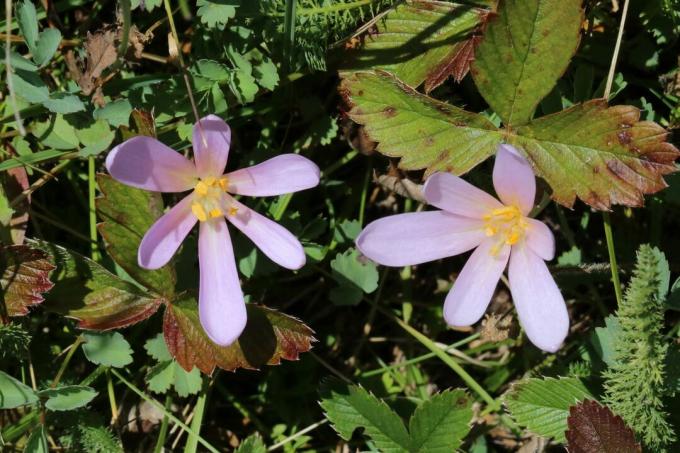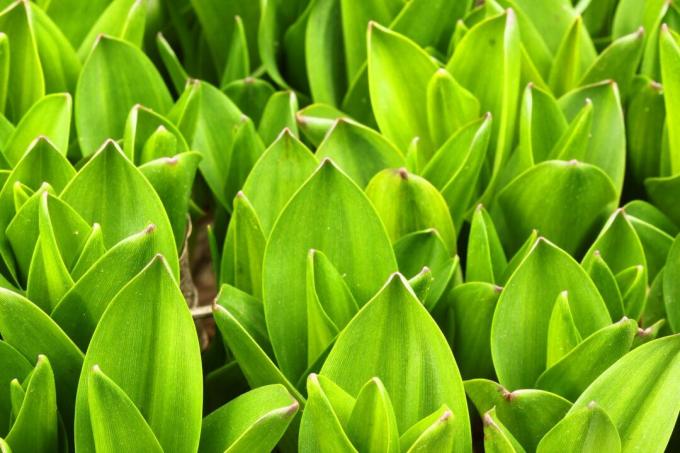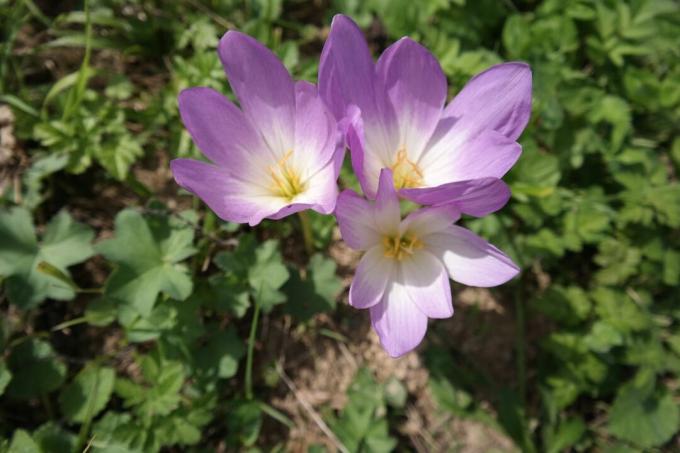How do you recognize the autumn crocus? Is it also suitable for the garden and what do you have to look out for with the pretty plant? You can find out everything about the autumn crocus here.

When the first leaves fall in early autumn, the autumn crocus (Colchicum autumnale) color in the landscape again. The pale violet flowers can then be seen in open meadows as well as in sparse forests and bring a touch of spring into the landscape preparing for winter. But the autumn crocus can also be admired as an ornamental plant in your own garden. However, be careful here: The autumn crocus is highly poisonous and was even voted “Poisonous Plant of the Year” in 2010. You can find out more interesting facts and tips on how to deal with the timeless plant here.
contents
- Autumn crocus: origin and characteristics
- Are autumn crocuses poisonous?
- Autumn Crocus and Crocus: What's the Difference?
- Planting and caring for autumn crocuses
- Use of autumn crocus
- Autumn crocuses in the hay: why they pose a danger to horses
Autumn crocus: origin and characteristics
The autumn crocus belongs to the crocus family (Colchicaceae) and is probably the most well-known species in our country. The plant occurs in large parts of southern and central Europe. While the leaves and seeds of the autumn crocus can only be seen in spring, the flowers appear in late summer or autumn. The uncovered, six-petalled flowers are also called "Naked Ladies" in English. Up to five flowers are formed per plant, which stand together in a tight group on the surface. The flowering period is from August to October. The flower height of the autumn crocus is 15 to 20 cm.

After the winter, the plant forms its leaves, which are up to 30 cm high. These are wide and elongated, quite thick-walled and slightly curved inwards at the tip. Particular care should be taken with the wild garlic-Search in the spring, because there are great similarities here. However, wild garlic leaves are much thinner, often a little limp and smell strongly of garlic.
Inside the funnel of leaves, egg-shaped capsule fruits form in spring, in which the seeds of the autumn crocus ripen over the summer. Then, in late summer, the fruit rupture, releasing small, black-brown seeds that are spread by ants or by the wind.
By the way: Like onion plants, the autumn crocus is a geophyte, ie it survives underground in a storage organ. Unlike, for example, the tulip, chess flower, imperial crown and ornamental onion, the outlasting organ is the From a botanical point of view, the autumn crocus is not an onion, but a tuber, which is formed by a thickening of the shoot will.
Are autumn crocuses poisonous?
All components of the autumn crocus are highly toxic. In the worst case, eating the leaves, tubers, flowers or seeds can lead to death. Although direct poisoning is not to be expected if you just touch it, wear gloves to be on the safe side and avoid contact with your mouth. Autumn crocuses represent a particular danger for children when they play with the parts of the plant. Typical symptoms of poisoning are nausea, vomiting, circulatory failure or respiratory paralysis. The content of the toxin colchicine continues to increase as the seeds mature and is highest in the seeds themselves. Just a few grams can kill an adult human.

Note Combat autumn crocus: Even if autumn crocuses are poisonous to us, bees and other pollinators like to fly to them and are therefore ideal sources of energy in the late season. However, if you are afraid for your children or animals and therefore want to drive the poisonous plants out of the garden, it makes sense to completely harvest the leaves in May. Without these energy suppliers, the tuber dies and cannot form again in the next year. Always wear gloves during this procedure.
Autumn Crocus and Crocus: What's the Difference?
Autumn crocuses and crocuses look very similar and there is a risk of confusion, especially with autumn crocuses. Unfortunately, the distinction is not that easy and requires a good eye. Based on these differences, the plants can be distinguished:
| characteristic | autumn crocus | crocus |
|---|---|---|
| heyday | Flowers only in autumn | Almost all species bloom in spring, including the only native crocus (Crocus vernus) |
| number of stamens | 6 | 3 |
| Occurrence of foliage and flowering | Flowers without foliage, developing their leaves only after flowering | Flower and foliage can be seen at the same time |
| stylus | Shorter, does not protrude beyond the petals | Significantly longer, may protrude beyond the petals |
| shape of the petals | Pointed | Usually rounded at the top |
| Size of underground tubers | 2.5 - 5 cm diameter, 7 cm long | 1.5 - 2.5 cm in diameter and just as long |
Planting and caring for autumn crocuses
If you still want to admire flowers in your garden later in the year, you can also plant autumn crocuses in your garden. For this purpose, in addition to the wild form, there are also white and pink cultivated forms, such as the double hybrid variety 'Waterlily', which is also called the water lily autumn crocus.

The autumn crocus can be placed in the ground between July and August and prefers sunny, wind-protected and moist locations. In their natural habitat, autumn crocuses like to grow between grasses, which explains their high, tubular flower stalks. Autumn crocuses feel very comfortable on sunny open spaces as well as on shady woody edges. The soil should be fresh to moist and rich in nutrients; sandy, loamy soils are ideal. Colchicum autumnale loves lime and grows very well on alkaline soils. In order for them to look good, no more than 5 - 9 plants per square meter should be planted, which results in a planting distance of about 30 - 40 cm. Plant the tubers at least 10 cm deep in the ground, otherwise they will easily suffer from drought. Autumn crocuses also reproduce through daughter tubers, which can create a whole carpet of plants on a rarely mown meadow or in a bed.
Tip: In addition to the species that is native to us, there are many more around the world. You can also go to our gardens Colchicum bornmuelleri or Colchicum speciosum pull in, which stand a little more firmly, but remain lower. C bornmuelleri makes larger, fuller flowers than C autumnal. C speciosum flowers white to dark violet and also very large.

Use of autumn crocus
Although colchicine is highly toxic, the substance is used to make medicines. It is mainly obtained from the seeds of the autumn crocus and is used, for example, in the treatment of gout. Colchicine is also used in plant breeding. The substance interrupts an important step in cell division and can therefore be used to multiply a plant's chromosome set.
Autumn crocuses in the hay: why they pose a danger to horses
Autumn crocuses are just as toxic to animals as they are to humans. The leaves in particular can therefore cause problems in the hay, because the poison is still effective even when it has dried. If the plant components are ingested with the feed, horses can develop a number of symptoms of poisoning, such as colic, cramps, sweating and circulatory disorders.
If you prefer to play it safe the next time you harvest wild garlic in the forest, you will find more detailed information in our special article Distinctive features of wild garlic and autumn crocus.
